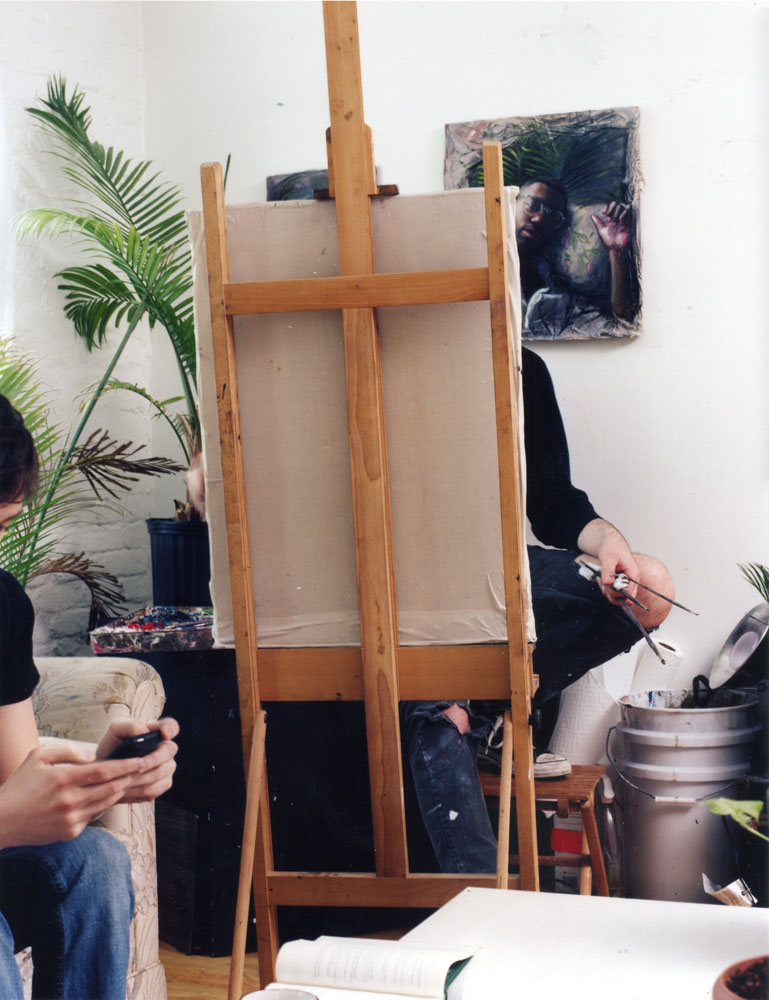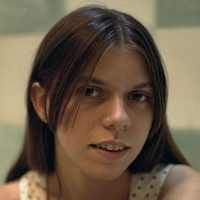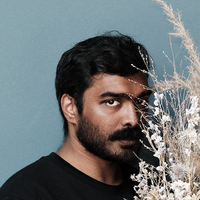On finding your form
Prelude
Conversation
On finding your form
Photographer Paul Sepuya discusses the origins of his creative practice, the realities involved in being a working artist, and what it means to call yourself a photographer.
As told to T. Cole Rachel, 2218 words.
Tags: Photography, Beginnings, Inspiration, Anxiety.
A lot of people know you because of your specific style of portraiture. How did your aesthetic develop, and how has it changed?
The stuff that people first started seeing was the work from 2005 to 2007, which wasn’t necessarily intuitive. I started making that work a few months after I’d finished undergrad, where I’d been doing these really over the top layered, mixed-media things. I wouldn’t really call those early pieces portraits, but they did involve subjects that had to sit for me in order for me to make them. I was experimenting with portraits, but I’d often lose interest and go back to making drawings.
In the beginning of 2005, I started to ask myself, “What is it that I’m actually drawn to? What am I trying to do here?” and I realized that it had to be something about relationships to people. Because I’d been doing this stuff that was very much about the construction of identity through clothing and all of these layers of stuff, it seemed smart to do the opposite, which was to strip it all down to these very simple setups, very undramatic lighting. Just these straightforward portraits. It became very minimal because it seemed important to take everything else away.
This happened to be around the same time that I was making this new group of friends, which was this very queer group of people. I was photographing people around me and I wanted this very even treatment of sexuality to be a part of it. Some of the images were quite sexual, but I think people projected that they were way more explicit then they actually were.
That’s really where my aesthetic developed. It was a reductive thing—taking things away that didn’t need to be there—and eventually I started to pull back a little and show more of the setting where these shoots were taking place, like in the kitchen or my bedroom or in the subject’s own personal spaces. So my practice developed by taking everything away and then gradually adding things back in.

“Darkroom” (2016)
So much of what is deemed “gay” art—particularly art made during the AIDS era—is fraught. There’s still this cloud hanging over representations of sexuality. Your work represented a kind of warmth that seemed like a move beyond that kind of thinking. You represented this younger generation of gay men that were coming of age in a time when intimacy wasn’t totally clouded by the specter of death.
Totally. Sometimes I’d think about the magazines I would sneak from the magazine stand in Santa Monica when I was a kid. What are the kinds of images I would want to see? The images I was making did relate to a kind of gay identity that wasn’t so fraught. I would think, what would it be like if gay sexuality were really more about, say, friendship? What if it were about some kind of casual, shared intimacy instead of coming from some sort of tormented narrative, which is what was so often being presented? It just came out of a space of friendship and inquiry. Physical, romantic, platonic, creative—all of that stuff. I mean, I had a lot of fun making those images. [laughs]
When you are working in this this established creative form—portrait photography—do you have to ask yourself, “What am I adding to this? What am I doing that hasn’t been done a million times before?”
I mean, at the time, I really didn’t know what I was doing, to be honest. I figured a lot of that out through public platforms—through zines and the internet. I was doing my work in my own little bubble and mostly just for myself. As I started to move out into a larger conversation about my work, as more people started to see it, people would say, “Oh, I’ve never seen something quite like this.”
I guess at some point I just realized that I had to stop trying so hard and that the one thing that I did have was a structure that I wanted to work in and the generosity and cooperation of friends. That’s all I needed.
I realized that there was this other audience out there, and that’s when I started to think, again, about those questions: Why am I doing this and what is it about? All we can really do is photograph what is around us and honestly I was just trying to figure out something for myself. I was looking out and wondering who all of these people were, people in my own neighborhood, and then moving out from there. It was a certain moment in time—the whole Brooklyn queer zine thing was in full effect. There were also a lot of people doing similar work, but I think the minimal aesthetic of my images helped separate my work from the other stuff.
I can’t say that I was doing something radically different with my images other than not trying to add on all these extra layers of crap. I guess at some point I realized that I had to stop trying so hard and that the one thing I did have was a structure I wanted to work in and the generosity and cooperation of friends. That’s all I needed. You just keep pushing and investigating and trying things and eventually you find your form. You find the thing that works for you specifically.

“Figure/ Ground Study” (2016)
,%202016,%20archival%20pigment%20print,%2060%20x%2080,%20from%20the%20project%20Studies,%202015-16.jpg)
“Study with Five Figures (3002)” (2016)
Of course it’s important to think about what you’re doing and why you’re doing it, but don’t you find that there’s also some kind of intuition involved as well? Sometimes you don’t know why you need to something, just that you need to.
That is true. The other thing that was important was the editing. For every one of those portraits that you saw, there are so many outtakes. Hundreds. When I mentioned that I didn’t really know what I was doing back when I started I wasn’t joking. I would take those minimal, straightforward portraits and then just be like, “Okay, I’m going to start off with a head shot and go from there” and then I would try all of these ridiculous things, so much stuff that I would later discard.
After I had dozens of images I would step back and try to look at what was the thing that was holding it all together. I had to figure out what it was really all about. It was about the people individually, the people collectively, the vertical and horizontal relationships—that was really the structure of the project. I think it’s always good to shoot a ton and then you often have to step back and look at what it is that you’ve got and what the project really needs. There are definitely a ton of silly outtakes. You have to be willing to throw a bunch of stuff away.
When you finished school was your ultimate goal to be a successful working artist? Or was the goal to just make work and then figure out some other way to make a living?
It kind of figured itself out, but I will say that there’s almost always a huge disconnect between appearances and reality. I’m really glad that I found a day job in arts administration when I was younger because I was working alongside artists and learning a lot about how things succeed and how they fail. I was working on grant stuff and that enabled me to pay the bills, but there were lots of people who only knew me from my day job as a Services Coordinator for an arts organization. I would always be like, “Oh yeah, I’m also an artist on the side.” Then there were the people who only knew me from my photographic work who would be like, “Oh, there’s Paul the photographer, he must be really successful.” There were times when I felt like I was just wasting money on film and going to the darkroom and making prints and posting things on the internet, when it didn’t seem like it was going anywhere.
It was good for me, because of that job, to have a very real world perspective of what it meant to be a working artist. I was seeing people who might have just had a big show at the Whitney applying for grants and not knowing how they were going to pay their bills. I got to see, “Oh, this is how it really works” and not just naively jump into it. I also had the experience of freelancing for several years, which was really, really shitty.

Site of a Portrait, T.M. Davy (2009)

Self-portrait (2006)
You’re teaching photography now. Do you find that your students want to know more about technique and image-making, or are they more concerned with real world stuff, like how to get a gallery or how to sell their work?
All you can tell them is, “You just have to keep working.” What I realized, even when things would get me really down, was that I had this knowledge that it wasn’t easy for anybody. I’d be like, “Okay, when it comes to applying for funding and grants, sometimes people apply for these things four or five times before they get one.” Also, I’ve seen someone not get funding for something just because one of the jurors woke up in a bad mood. You can’t take rejection personally. There are so many factors. Also, it’s just persistence.
I always tell people not to get too focused on any one city when it comes to showing your work—there are lots of places to show your work, lots of non-profit spaces, lots of galleries that aren’t in New York or London or LA. Apply for everything. Also, there’s really no rhyme or reason to any of it. For example, no one really cared about my work in New York until after I moved away, then suddenly people wanted to put my work in shows there. You just have to be constantly working, applying, showing up. It really is all about persistence.
When people ask you what you do, do you say that you’re a photographer?
Yes, I think so. I would say I don’t know if I like photography, but it’s good.
What would make you feel that way?
I think a lot of the people just kind of get caught up in the idea of “images” and often they’re very much detached from the physical objects themselves. In regards to photography, I always think of how images—what we think of as photographs—float around in Pinterest and Tumblr and places like that. A lot of people are photographers but they don’t actually ever actually print anything. The work is never actually produced.
If you’re doing purely internet-based art, that’s something totally different. Regardless of what format you’re working in you still have to consider certain things when you’re talking about images: What is it? What is the relationship to scale and its presence? How is it seen? Is it a photograph that relates to the history of the album and the book where a lot of photographic history rests? Is it an image that is trying to be in conversation with painting or other visual art forms? What is the intent? What kind of photograph is it? How is it approached? How is it read? It sounds stupid, maybe, but I always think those are the things that an artist has to think about, it’s something bigger or separate than just being about photography… does that make sense?
%20(2011,%20C-print,%2010x8).jpg)
Studio, March 2 (2011)
You are a visual artist who uses photographs to make your art. Does that feel more correct?
That feels right. You’ve got to make them. I think one of the reasons this question always comes up is because there’s always this fear that photography will somehow slip away or become a purely commercial product. There is this fear that it will become devalued now that everyone with a phone considers themselves a photographer. I think it’s kind of silly, actually. I don’t know any painters saying things like, “I don’t think I can call myself a painter because a painter is someone who paints the walls in someone’s apartment and what I do is fine art.” You can call yourself whatever you like—think of your practice in whatever terms you want—as long as you’re making the work.
Paul Sepuya recommends:
- The Movement for Black Lives
- The ACLU
- T.M. Davy’s exhibition, Horses, at 11R
- Wangechi Mutu’s exhibition, ‘Ndoro Na Miti, at Gladstone Gallery
- Francis Picabia at MoMA
- Name
- Paul Sepuya
- Vocation
- Photographer, Artist
- Fact
- Paul Mpagi Sepuya is a photographer and artist currently based in Los Angeles. This is how he describes his creative practice: “I make photographs, books, and installations rooted in portraiture, homoerotic visual culture, and the function of the studio. Portraiture is the foundation of my practice. The subjects appearing in my work are a cast of friends, intimates and muses. They are founded in ongoing relationships mediated by the making and production of photographs.”

Some Things
Pagination



